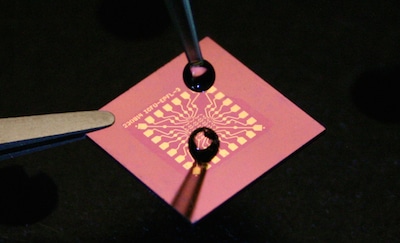In 2004, a new material with superlative properties was rediscovered and isolated by researchers Prof Andre Geim and Prof Kostya Novoselov at The University of Manchester, an achievement for which they were awarded the Nobel Prize in Physics in 2010. This material, called Graphene is dubbed as a ‘supermaterial’ and its remarkable physical traits have been hailed across the scientific community for the vast potential they offers in applications for physics and engineering.
If you scroll through the history of mankind, the spread of civilizations and evolution of technology have been marked by the mastery of elements. From the Bronze and the Iron ages, to the dominance of the Roman Empire and the rise of the American steel industry to the modern silicon semiconductors-driven computer and information technology era, many watershed moments in history have been defined by advancements in the fields of metals and materials.
Read here to know about the history of this unique material while the video below will explain what Graphene is all about-
Graphene-based nanomaterial find applications in diverse areas, particularly in the field of energy. For instance, the material considerably improves energy capacity and charge rate in rechargeable batteries; makes superior supercapacitors for energy storage; can be developed to make inexpensive solar cells; and find applications as substrates for catalytic systems in the form of multifunctional graphene mats.
Let’s take a look at some of the recent developments surrounding Graphene:
Mixing Silly Putty With Graphene Can Detect Human Pulse
According to latest research, mixing homemade ‘silly putty’-that gooey type stuff used by kids as toys, with graphene creates a composite, enhanced putty called G-putty- a sensor so sensitive it can detect the footsteps of a spider.

The researchers who led the study have stated that they intend to use the new sensor in detecting human vital signs, such as pulses and breathing, and which may find applications in wearable health trackers for the future. Jonathan Coleman, a chemical physicist at the Advanced Materials and Bioengineering Research Center in Ireland who lead the work, added that they had filed a patent for the new technology and were in talks with companies keen on commercializing it.
You can read the details of their study.
Student Designs Award-Winning Graphene Battery That Can Reduce EV Charging Times
Josh de Wit, a second-year Mechanical Engineering student at the University of Sussex, has won the Autocar-Courland Next Generation Award for 2016 with a new, radical concept that could significantly reduce charging times for electric vehicles (EVs). Batteries are a major headache for the EV industry, with huge and cumbersome designs that take a long time to charge and finish very quickly- a major factor that is preventing EVs from attaining mainstream popularity.
The new design uses Graphene, which according to Josh, would take way less time to charge, store more energy, be cost-effective and much stronger and lighter than existing products.
Graphene Textiles To Boost Use Of Wearable Electronics
Researchers at the Cambridge Graphene Centre (CGC) at the University of Cambridge, in collaboration with scientists at Jiangnan University, China, have developed a low-cost, environmental-friendly method to deposit graphene-based inks onto cotton to produce a conductive textile. The research shows wearable motion sensor based around the conductive cotton, thus opening up new possibilities for flexible and wearable electronics, and all this without using toxic and expensive processes.
For the process, the team created inks of chemically modified graphene flakes that are more adhesive to cotton fibers than unmodified graphene. The conductivity of the modified graphene is improved by heat treatment, after the ink has been deposited on the fabric. The modified substance is adhesive to the cotton fiber in the same way as colored dyes.
‘Other conductive inks are made from precious metals such as silver, which makes them very expensive to produce and not sustainable, whereas graphene is both cheap, environmentally-friendly, and chemically compatible with cotton,’ said Dr Felice Torrisi of CGC.
‘This method will allow us to put electronic systems directly into clothes. It’s an incredible enabling technology for smart textiles,’ adds co-author Professor Chaoxia Wang of Jiangnan University.
Nano-calligraphy And Miniaturized Sensors
Scientists at The University of Manchester and Karlsruhe Institute of Technology have developed a new method to chemically modify small regions of graphene with razor-sharp precision, thus creating extremely miniaturized chemical and biological sensors.
The researchers used technology that is similar to writing with a fountain pen or quill, to supply chemical droplets to the surface of graphene in very small volumes. They used droplets of chemicals less than 100 attoliters (10-16 L) in volume; i.e. 1/10,000,000,000,000,000th of a liter to obtain fine chemical patterns.

‘Two types of ‘pens’ were used, one which is dipped into the reactive ‘ink’ like a quill to cover the nib, and the other where the ink is filled into a reservoir and flows through a channel in the nib, just like in a fountain pen. An array of such micro-pens are moved over the graphene surface to deliver the chemical droplets which react with the graphene. The first method is known as Dip-Pen Nanolithography (DPN) and the latter is known as Microchannel Cantilever Spotting (µCS),’ says Dr. Vijayaraghavan.
‘By chemically modifying the graphene in such small regions, we can develop chemical and biological sensors which only require very small volumes of fluid to detect various constituents. This, combined with the high sensitivity of graphene sensors, leads us to imagine that in the future we could perform a full blood test on a patient with just one tiny drop of blood, instead of a full syringe,’ adds Dr. Michael Hirtz.
This new technology is important for enabling graphene sensors for real-world applications, such as their use during blood tests where they can minimize the amount of blood a patient is required to give.











You have glimpsed the significance of the unique properties of the elements in the evolution of technology.